But that is so far from the truth!
If you want to meet the soul of Alagna, you have to visit it in September. After the super crowded period in August, Alagna returns to savoring the slow pace and genuine life of a mountain village with its everyday life and human touch, but with a calendar filled to the brim of events.
The top 5 events in September
But in Alagna in September you can also choose to do nothing, to relax in our hotels, be spoiled and pampered with care and meticulous attention. Because we in Alagna are convinced that if it is true that the world today runs at a fast pace, it is also true that from total idleness the most innovative ideas are born
Book now your September stay in Alagna Valsesia!
Those who have been lucky enough to spend a weekend or a few weeks in Alagna already know: our territory is not only the freeride paradise , but also the kingdom of locally produced products (km 0) and “slow” holidays. There are many gastronomy tours and just as many excursions recommended for those who love to travel slowly. Read, for example, what we wrote in the article Products from our territory, lunch & SPA: a typical day in Alagna , and you will realize what and how many leisure opportunities we offer regarding food and wine, cultural and historical. The names to be mentioned are many, from La Latteria, a real temple of good food in the center of Alagna, perfect for stocking up on cheese, pork salami made by us, bread and naturally leavened cookies and all types of delicacies from the territory. For the sweet toothed travelers, we have, among other products, the ‘miaccia’, a local delicacy you just have to taste, at Mario’s bar, an inevitable meeting point before dinner.
PARKS AND ATTRACTIONS FOR A SLOW HOLIDAY IN EVERY SEASON
Slow tourism in the Alta Val Sesia national park is perhaps the epitome of a slow holiday. But there are also other destinations and sights to satisfy your desire to slow down like visiting the beautiful Walser museum, where you can spend some time with family and friends admiring antique collections and artefacts from the Walser culture. Over 650 objects dated between the fourteenth and twentieth centuries, placed on the outside and inside a mountain hut dated 16Alta Valsesia Natural Park, the higest in Europe (alagna.it)38 in the context of an authentic Walser village, provide insight into the knowledge of this extraordinary people who founded a civilization in this territory in complete harmony with nature and its resources. There are also numerous opportunities for trekking and slow walks , suitable for all levels of fitness, athletic preparation and difficulty ( click link here for an updated map ).Alta Valsesia Natural Park, the higest in Europe (alagna.it)
For sport fishing enthusiasts, the river Sesia’s clear waters flow right up to Mont Rosa at a height of about 2,500 meters. Trout fishing is an ancient tradition, which is rooted in the centuries of the centuries, so much so it is home to the famous Valsesian fly fishing, a technique originating in this territory to provoke the most clever and cunning prey with simple but effective gestures. Another slow sport is cycling, or better, mountain biking, with dozens of easy paths mid-mountain and suitable for families and children, but there are also more demanding routes for those seeking an adrenaline rush. A complete offer in every season of the year, to experience the slow rhythm of your breath and silence that reigns here undisturbed, far away from “mass tourism ".
Discover the Slow life breakaway packages for your slow holiday on Monte Rosa!
The challenge is about to begin: every year we prepare for the upcoming opening of Rifugio Capanna Margherita, the most charming, most scenic and definitely the highest in Europe. With its 4.456 meters above sea level, Capanna Margherita, the other name it is known for, is situated on top of Punta Gnifetti in the Monte Rosa mountain range, attracting hiking enthusiasts both in winter and in summer. In summer the ascent to Capanna Margherita is less difficult, but also accessible to non professionals, even with all the meteorological and climatic conditions that can make an outing such as this quite challenging. Naturally, not just anyone will succeed: it takes a certain level of physical preparation, a good dose of courage and, as always, we advise the support of UIAGM alpine guides . The next step now, is taking the first step towards the summit and ... go!
In winter the ascent to Capanna Margherita is possibile but the rooms inside are closed. Therefore, the best time to take advantage of what the refuge can offer is during the mid months of summer, thanks to the perfect organization of the structure and mindful management which pays careful attention to environmental issues. In fact Capanna Margherita is equipped with every comfort you can think of at high altitude, from bar and restaurant facilities to electric lighting and it has a quality certificate UNI EN ISO 14001 (certifying a minimum impact on the surrounding environment). There is an Internet connection and even a small library where you can spend some time in absolute tranquility in the company of a good book. The surrounding landscape is sublime with a view that sweeps over the glaciers and Parrot, Lyskamm, Zumstein and Dufour peaks.
The structure sleeps 70 in rooms with bunk beds, so it is advisable to plan ahead and book to ensure a place even if you only plan to stay for one day! Opening of the refuge in 2016 will run from 18th June to 11th September. The dates are indicative so please double-check our website or better yet, subscribe to our newsletter or follow our Facebook page . As always, we strongly suggest, prudence . Remember that the climb is very tecnical and you must have the necessary and appropriate skills and be in the company of expert guides if you do not have it. A little common sense will amply reward your effort for such a high climb. Prepare your boots ….and let’s go!
Book your tour at Capanna Regina Margherita online
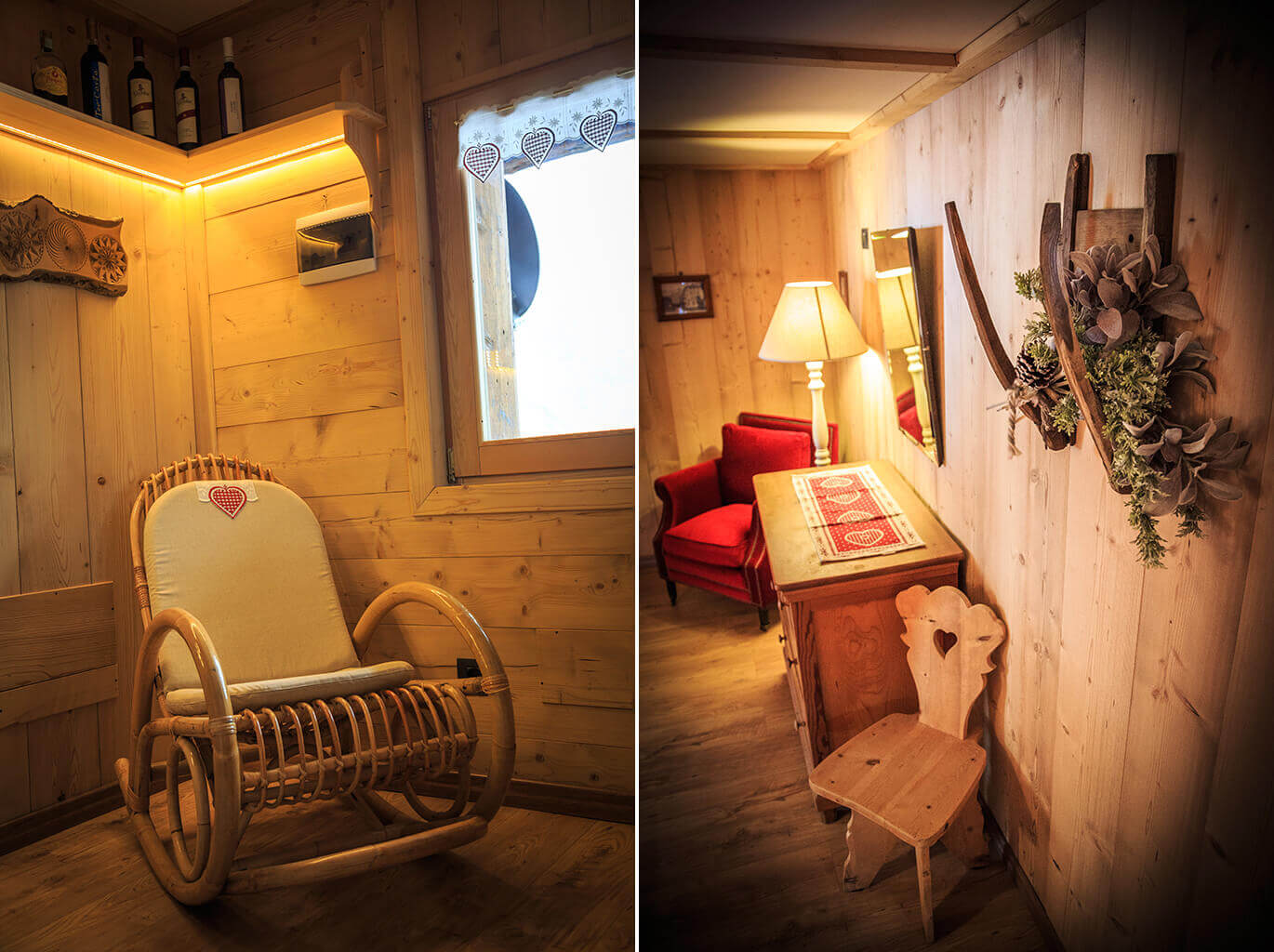 Spring, the regeneration time! Looking for a charming place to relax and read a book in peace? Far away from stress, noise and traffic? Baita Bonda is the place of your dreams: woods, gorgeous views and silence. One spacious bedroom apartment with 2/3 beds, intimate setting, €150 for long weekends in April, € 600 for the whole month. Click here to see more photos of Baita Bonda
Spring, the regeneration time! Looking for a charming place to relax and read a book in peace? Far away from stress, noise and traffic? Baita Bonda is the place of your dreams: woods, gorgeous views and silence. One spacious bedroom apartment with 2/3 beds, intimate setting, €150 for long weekends in April, € 600 for the whole month. Click here to see more photos of Baita Bonda
Looking for a 4 star hotel at a two star price? Hotel Cristallo offers a week end in April at an amazing rate: €50 B&B! colourful rooms, relaxation area with heated pool and sauna. Click here to us discover more about the hotel Cristallo
 |
|
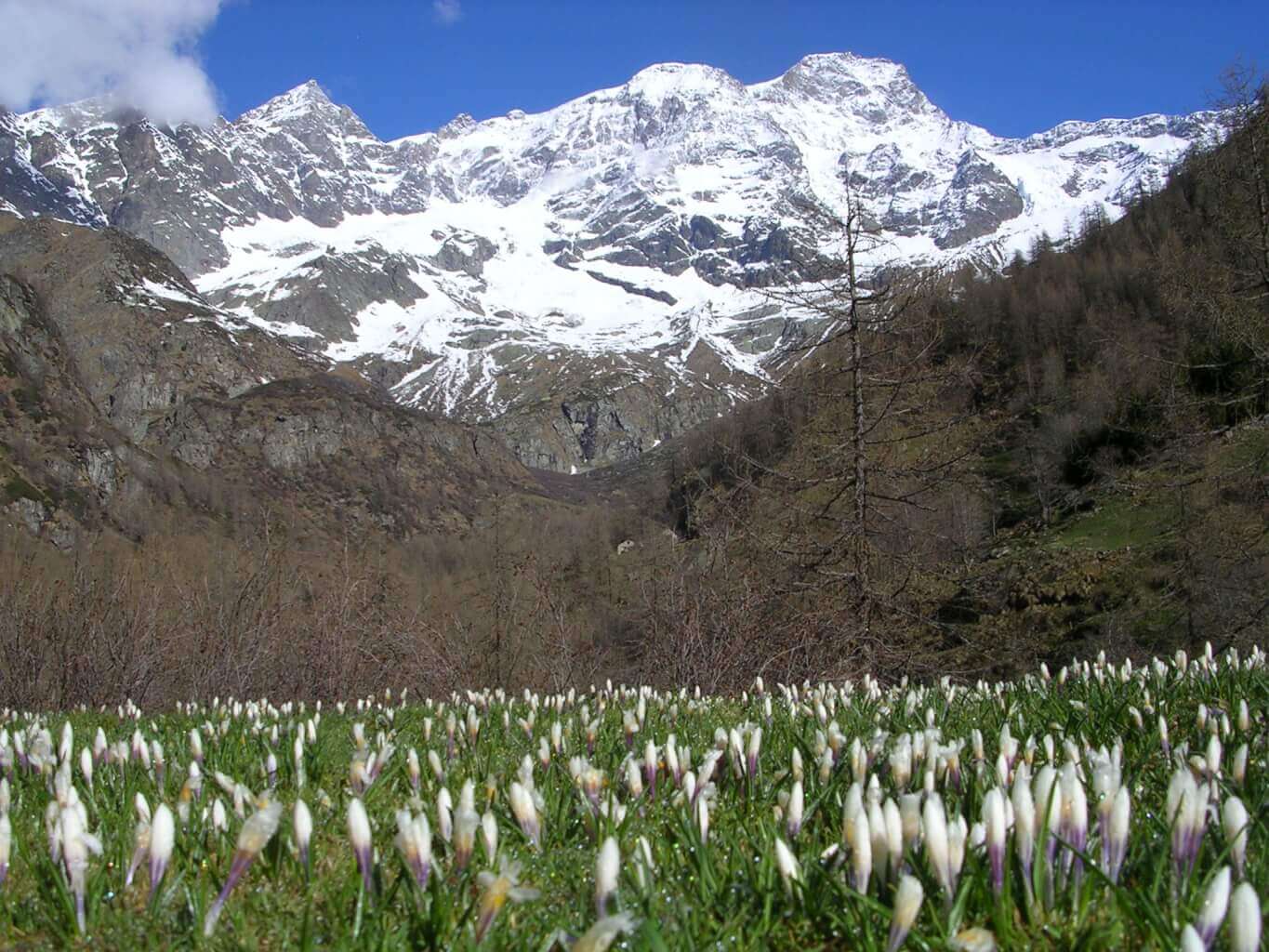 |
| A visit to the church in Riva to see its magnificent fresco | Hikes to the Felice Farm, the zero food mile mecca | 5 things to to see and do in Alagna in spring |
Well, winter 2016 has gone. The Alagna lifts close on April10th, but slopes and off-piste skiing are still excellent. Spring snow is already there, the mountain huts are open, we enjoy cold but sunny days: everything seems as if this late started season does not want to finish.
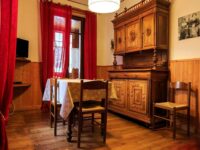 |
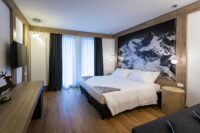 |
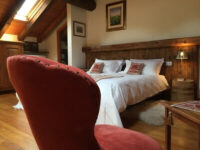 |
| Casa Smitt apartments week 3-10 April 550 euro inclusive of costs, final cleaning and parking. Two bedrooms apartment with living, kitchen and a large balcony. Long weekend in April, from Friday to Sunday 180 euro |
Mirtillo Rosso Family hotel from March 29th purposes the best deals of the season!2/4 night for 2 adults and a kid from 61 euro per person. 7 night from 48 euro per person, breakfast and wellness centre entrance included |
Tre Alberi Liberi B&B April 3rd to April 10th: 7 nights for two people in double room at the price of 665. Late check out, sauna, wifi and organic breakfast included. Long weekends from Thursday to Sunday, or Friday – Monday from euro 260. |
Curiosities
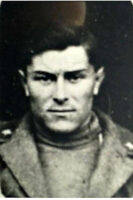 It was built in 1870 and was first given the name “Villa dei Fiori”. It was only composed by three large apartments that were rented out to the rich tourists that used to spend their summer in Alagna at the beginning of the XX Century.
It was built in 1870 and was first given the name “Villa dei Fiori”. It was only composed by three large apartments that were rented out to the rich tourists that used to spend their summer in Alagna at the beginning of the XX Century.
After WW1 was bought by Pietro Smitt, former gunner who made its fortune in France as decorator.
From there the name. Today the house is run by Anna, who wants to transform it into an ideal place for families, because she likes houses with a lot of children. The apartments have all two bedrooms to grant peaceful sleeps to parents and kids, a large living to spend time together and a kitchen, in order to give space to the cooks, that we know, are irritable whilst cooking.
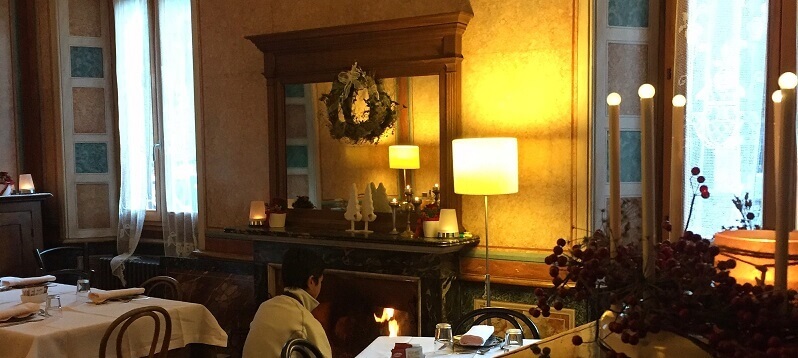
This B&B is also located in an old villa formerly built with the purpose of hosting rich families of the early 900 with their servants. The old style of the house has been maintained after the recent refurbishment, but the name is completely new and express the owner's philosophy. Three is the recurrent and lucky number of the family; the Tree is the essence: symbol of sustainability and balance, sturdy roots and foliage free to follow the wind. And those trees are also free, free because the Sesia Valley in 1400 declared its freedom in fron of the Duke of Milan, and even now the people like their freedom above every thing
Mirtillo is Father Christmas' raindeer, the red nosed one, that seems to be settled there to pep up the days of families on holidays around the Monte Rosa. For him Stefano decided to build an adequate house: 60 family rooms, one in and outdoor swimming pool, buffet restaurant and miniclub.
Who said that you only visit Alagna to ski? Obviously freeride paradise, and Monterosaski generally represent the main attractions during the winter season, but it offers many other alternative ways to relax. For example a tour with Alagna Card. It starts with offers from La Latteria, the dairy shop where you can buy cheeses, jam and honey, pork salami, naturally leavened bread, biscuits and much much more. For those who have the Alagna Card there is a product discount of 10%. The card can also be used in two other stores: the Pharmacy Alta Valsesia and the Healthcare Store Angolo delle Alpi, both specializing in products for your face and body. Here too with your Alagna Card you can save 10 euro for every 100 euro spent (a discount of 10%). And if in the meantime it is time to have lunch, we recommend the restaurants Montagna di Luce (– 10% at lunchtime every Wednesday) and Ca Nosta (– 10% a lunchtime every Tuesday as well as in the evening), with an offer on traditional mouth-watering cuisine!)
Your day continues with a trip to the Baite Rosa Spa (– 20% on Mondays and Wednesdays), Mirtillo Rosso (– 10% at entrance every day) or Regina Margherita (– 10% from Monday to Thursday), just the place to relax in a sauna, turkish baths and jacuzzis. For those who wish to emerse themselves in the culture of their surroundings, a definite stop is Walser Museum, where a guided tour is free at each entry (for those with an Alagna Card). The Walser Museum tells and depicts the history of the valleys and of the culture of the people who live here, who arrived centuries ago by crossing the Alps. A legendary epic accompanied by artifacts, documents and illuminating testimonies.
You will for sure have walked up a slight apetite by now so, head towards Baita della Eli (free aperitive from Monday to Friday with your Alagna Card) or go to Bar Mario (here you can have a free ‘miaccia’ if you order a cocktail). The day draws to a close and it’s time for dinner. We leave you the pleasure of discovering your favourite place, reminding you that your la Alagna Card allows you access to discounts of up to 20% in certain places. For futher information go to the webpage Alagna Card: by entering your data and the code on the card, it is possible to activate it. The card, free of charge, is available at the hotels. Alternatively you can access the webpage where you will find a complete list of promotions. Let the fun begin!
With your Alagna Card you can win 2 skipasses for Monterosaski: enter now!
Recently a novelty which we are particularly proud of has appeared on the Home Page of our website. It is a card that allows access to discounts and special agreements reserved to those who have one. Alagna Card is undoubtedly one of the most important news flashes of Alagna-Valsesia for the 2015/2016 season . Anyone can request and obtain lower prices and free services: just stay in one of the many facilities participating in the initiative and, at a later time, proceed with the online registration on this website. Among the hotels on the circuit Alagna Card are B & B 3Alberi Liberi, B & B 10 & Lode, Hotel Cristallo, Mirtillo Rosso Family Hotel, Residence Alagna2000, Residence Pietre Gemelle, Hostel La Minera, Hotel Montagna di Luce, Residence Indren Hus, Casa Smitt, Residence Casa dei Fiori, Agriturism Alagna, Residence Mirtillo Blu, B & B Borgo dei Folli, Residence Baita Rosa and Residence Baita Walser Reale
To receive the card, simply activate it by filling out the form on the home page Alagna Cards. Add your details and the code of the card and you're done. Once activated, the card is enabled to allow you discounts and reserved specials. Some examples? Free shuttle transport between Alagna Riva ski lift and Wold, 10% lunch discount every Wednesday at Restaurant Montagna di Luce, 20% discount on Mondays and Wednesdays at SPA Baita Rosa, free aperatif on Thursdays at lunchtime at the Union Restaurant and a free guided tour to the Walser Museum, cheese tasting at Betty Food when you spend more than 10 €, 10% discount on cosmetics at Parafarmacia Angolo delle Alpi, and much, much more!
In addition, those who register have the opportunity to participate in the competition for the extraction of 2 Monterosaski ski passes valid for 6 days! The district has a total of 180 km of slopes of which 170 km covered with artificial snow, with a total of 37 ski lifts (14 Chairlifts, 10 Baby Snow Parks / treadmill for beginners and children, 4 ski lifts, 5 Gondola lifts (Telecabins), 3 cableways, 1 Funicular and 69 slopes) distributed in 6 alpine resorts in Valle d'Aosta and Piedmont (Champoluc, Antagnod, Brusson, Gressoney-LaTrinité, Gressoney-Saint-Jean and Alagna). In short, a paradise for amateur skiers and experts, with areas dedicated to ski touring and off-piste (Freeride Paradise).
Choose to save: activate your card now or get more information!
If there is a place to satisfy your desire for hiking, even with snowshoes, that place is Monte Rosa. There are so many trails: short, medium, long, with slight uphill or steep, outdoors in the shade of the woods, following a stream or through the beautiful valleys of Alagna-Valsesia. There is a really wide range of choice, suitable for all levels of experience or age. Just the thought makes you want to put on your boots and go! But be careful: the first rule to enjoy the best hiking experience alone or in the company is knowing the hiking trails. Because there are so many trails and all of them valid, you should know how to orientate yourself, not only geographically, but also in terms of trail selection. A linear path is not necessarily suitable, even for little children, and it is possible that a route at high altitude might be more practical for those who do not have much experience. The important thing is to have a map handy. To facilitate the task, we have prepared one especially for you!
ATTRACTIONS, JOURNEY TIME, VERTICAL DROP AND DIFFICULTY
On the trail map of Alagna Valsesia- Monte Rosa, you will find lots of useful information to organize your adventure hike. For each route we have indicated, in order from left to right, the international numbering, the destination, the altitude, the difficulty, the travel time and what the level of satisfaction is according to our dispassionate opinion. For the level of difficulty, one of the highlights of any hiking map, we used the symbols of the traffic light. 1 green dot for easy trails, 2 yellow dots for medium trails, 3 red dots for the difficult paths. The word "alpine" signals paths that require a significant technical level. We have also reserved a brief introduction to cultural, sport and tips about the communes of Alagna and Riva Valdobbiadene.
To complete the map, in addition to the streetmap, here are three insights on what we believe are the most beautiful paths to be done in either spring, summer or fall. We are talking about Orteltol (No. 203), a hiking trail to discover the Walser settlements of Otro, rich in natural beauty, cultural, historical and artistic gems. Then there is the Old pass of Colle di Valdobbia (No. 201), from the village of Ca 'Janzo to the refuge Ospizio Sottile at an altitude of 2,480 meters above sea level. Finally the wonderful trail 206 - 206th - 207, dubbed "Under the glaciers of Monte Rosa", an itinerary that runs almost entirely within the natural park of High Valsesia, at the foot of the glaciers that fall down the valley from the south wall east of Monte Rosa. A unique spectacle for both the eyes and spirit!
Download the route map of Alagna - Monte Rosa now!
Alagna-Valsesia offers a varied selection of superb experiences each year for those who love winter sports. From freeride skiing, snowboarding and outings only for snowshoeing, to heli-skiing in the heart of Monte Rosa. Never a dull moment for tourists and vacationers of all ages, experienced and not, who are united by their passion for the mountains and the snow. The 2015/2016 season promises to be super interesting judging by the many new specials on offer. The snow has already arrived and until 8 December you can get your fill of special offers. So come along and discover what this winter season has in store for us!
THE OPENING OF THE MIRTILLO ROSSO FAMILY HOTEL
December 23, 2015 is a date to mark on the calendar. In Riva Valdobbia, a village a short distance from Alagna-Valsesia, the Mirtillo Family Hotel opens its doors. A cutting-edge facility with 59 rooms from standard to family and suites, a restaurant with 130 seats, a family spa with 2 pools, a lounge bar and sunbathed terrace for sun tanning and events. Also a shuttle bus to the Monterosa-ski lift as well as the airports. It’s time to get prepared for the official inauguration!
PLUS REDUCED RATES FOR UNDER 18’s
Those born after 31/10/1997 benefit from reduced rates on ski passes. First the reduction was only applied to under 14’s. The formula must be requested at the ticket office and is called the Monterosa Ski Ticket Promo Teen under 18.
NEW EQUIPMENT FOR THE SKILIFTS
The Pianalunga- Bocchetta chairlift will be equipped with a boarding platform, a great help for those who are beginners with skiing or snowboarding.
SHUTTLE SERVICE FOR ALAGNA AGRITOURISM
The Alagna agriturismo is located at the foot of Monte Rosa in the ancient village Walser "the Rusa" (Fun for Rufinu), is offering a free winter shuttle service this year. Getting to the slopes will be even easier!
BAR/RESTAURANT ‘MONTAGNA DI LUCE’
The Montagna di luce restaurant, on the ground floor of the hotel with the same name, has a new chef and a brand new natural and organic food menu, with Walser food tasting, cider, mead and excellent craft beer. The shuttle service for the ski lifts even arrives here!
FREERIDER PUB RESTAURANT
The Freerider pub also has important changes on the horizon. In addition to the renovation of the interior, the restaurant is offering typical cuisine based on rich buffets, high quality burgers and mega aperitives for the season 2015/2016. There will be a screen showing the sports videos of clients and other live events, but also live music and bar. The shuttle service for ski lifts stops here as well. Freerider Pub Restaurant: a cult meeting place for teenagers!
B&B 3 ALBERI LIBERI
Back by popular demand are ‘evenings in the tub’ at B&B 3 Alberi Liberi, via Nicolao Sottile at Riva Valdobbia (VC). From this year fares also include snowshoes and ski poles, subject to availability and reservation (4 pairs in total).
RESTAURANT DIR UND DON
Even the pizza restaurant Dir und Don is changing their style and is reformulating their menu to one strictly Walser. Authentic, abundant cuisine, the result of a passionate research on the tastes, the ingredients and the terminology of the original territory. Well done!
A DEPANDANCE FOR CASA SMITT
The apartments of Casa Smitt now boast a real depandance in front of the cable car. A real cache coeur for those seeking privacy in pure Walser style.
A PHARMACY IS OPENING IN THE CENTER OF RIVA
The pharmacy Angolo dei Alpi is opening a second new store in the center of Riva. Same owners, same service that pays careful attention to the needs of a diverse clientele, with a wide selection of wellness products, diet and health, all strictly organic.
We look forward to seeing you in Alagna for an even more spectaculous vacation: make your reservation now!
September and October have flown by and it's time to prepare for winter. The key words to relive an adventure immersed in snow are 3: snowshoeing, heli-skiing and off-piste (freeride). You can organize each of these activities on your own, but our experience suggests caution to avoid that your adventure turns into tragedy. Even with snowshoes you have to be careful. Many tourists each year get lost in the woods because they lose track of the time and a serene afternoon turns into a nasty night or because they don’t have a simple map. We at Alagna we have heard far too many of stories like these. If you like walking in the silence of a snow-covered forest, good for you, but watch out for dangers. The smartest way to go snowshoeing is to join our groups, starting from January 4, 2016, every Sunday at 9:30. For only 30 € you have all the necessary equipment and the company of a qualified guide. Here are the details regarding our outings hiking in snow shoes !
WELCOME BACK ELISKI AND OFF-PISTE, WELCOME BACK ADRENALINE
If prudence is the operative word when snowshoeing, it is fundamental to put your safety in the hands of professionals guides when heli-skiing and off-piste skiing. Our expert UIAGM guides and Air Service Center pilots will be happy to take you to the highest peaks of Monte Rosa, where the air is thin and where the alpine environment shows its more noble and savage facade. The heli-skiing and freeride tours represent a unique opportunity to practice extreme sports and experience the mountains from a unique perspective, chasing adrenalin and fun, with a guarantee of safety that you surely could not have if you were alone. Aside from random weather checks, accurate assessments of routes are made before leaving, taking the Avalanche Bulletins and the experience of the guides into account.
When everything is ready, you’re off to your destination. Colle del Lys, Colle Ippolita, Valle Nera, il Cavallo ... these and other goals are the starting point for adrenaline pumping descents. More information about off-piste descents and freeride paradise can be found on our website and in the articles of this blog. Please note that the reservation number is 0163 922993. Alternatively you can write an email to the email address skiguide@alagna.it . When choosing Alagna.it means savouring the taste for adventure with respect to the mountain and the environment. Contact us for more information!
On this site, as many of you already know, you can build your vacation automatically or almost, but also choose the vacation package that best suits the tastes and personal needs of each one. Wonderful ideas to spend the winter in Alagna with family or friends, including track days, hiking, fishing, snowshoeing ... But there's more: next winter Alagna could be the perfect opportunity to live these experiences at an even more affordable price. This year we inaugurated the new section dedicated to best offers, all-inclusive proposals for those who like heli-skiing, freeride or simply the quiet of a house in the mountains. The solutions that we created range from Weekend Heliskiing in Alagna to Freeride Week, passing by the long bridge of the Immaculate on 8 December in the apartments of Casa Smitt.
SPECIAL DISCOUNT IF YOU BOOK BEFORE December 8, 2015
Alagna in winter is a paradise for freeride: so amongst our special offers we could not Not include offers dedicated to downhill skiing and snowboarding. Our proposal provides for a stay of 2 nights and 3 days with ski pass included, helicopter flight, accompanied by a guide, dinners and safety kit, all at a super discounted price. Some examples? House Meadows B & B + 3 days restaurant dinner with a roulette formula (3 dinners in restaurants in the center of Alagna) 900 € / person instead of 970, or half board at hotel Mountain of Light at 910 € / person instead of 990, or half board at residence Indren Hus at 880 € / person instead of 950. A complete special offer, to be booked by the 8 December, 2015 subject to availability.
How about an unbeatable week of freeride in Alagna, seven days including a ski pass, guides, dinners and safety kit. Where? In one of the apartments Casa Smitt, at 1170 EUR / person instead of 1290. Or in residence Casa dei Fiori at 1090 EUR / person instead of € 1210 ... and many more! For those who love to lounge, spend a week from 8 to 15 December in the apartments Casa Smitt (5 bedroomed house in the center of Alagna), discounted by 15% to € 460 a week instead of 550. As above, book by 8 December 2015. You just have to sit down and choose the best solution, the snow is already here!
Looking for special customised offers? Send your request without obligation!
The arrival of autumn in Valsesia is accompanied by fairs, festivals and events , but also by a great desire to go out and enjoy the last days of warm sun far from the music and life in the country. Opportunities for a walk or a real trekking trip for one or more days are plentiful. There is no need to be an expert: simply wear a pair of boots, comfortable clothes and set off on one of the many "easy routes" chosen from the section Trekking and walks. For those who prefer more challenging walks, we recommend relying on one of our qualified guides found on this page. Either way you'll be spoiled for choice: to simplify your task, we suggest 5 good ideas for hiking in the autumn months of October and November. Ready?
1) THE TAILLI LAKES, A MYSTIC PLACE IN THE VALLEY OTRO
A trek unsuitable for children, but a fascinating one which leads to the Laghi Tailli, one of the most mystical places of all in Val d'Otro. A hiking time of 3 hours and 30 minutes, is what it takes to climb the 1,200 meters from the starting point to arrival at 2775meters. To welcome all hikers is a landscape of meadows, rocks, small ravines, valleys and of course the lakes, soft and lovely, carved into the rock.
2) THE PATH OF ART CAMPERTOGNO-ARGNACCA-CANGELLO
Focused on art, the sentiero di campertogno-argnacca-cagnello spans centuries of pictorial, history and architecture of our valleys. From the sixteenth century oratory of San Marco to the chapel of Scarpia, from the Church of Our Lady of Callone to the oratory of San Bernardo ... a path for those who love art, to be enjoyed in the open surrounded by an autumn landscape.
3) THE NATURE RESERVE OF THE SACRED MOUNTAIN OF VARALLO
Varallo and the Sacro Monte are a-must- see for anyone visiting Alagna and Valsesia. In this corner of the Alps, elected as the Special Nature Reserve, many vestiges of the past, firstly the Santa Maria delle Grazie with its famous Gaudenzian wall, are preserved . Do not forget that the Holy Mount of Varallo remains the oldest of the "new Jerusalem", reproductions of the holy places of Palestine and the scenes of Christ's life which were spread during the anti-reform years.
4) THE PATH ON THE SLOPES OF MONTE ROSA
Another good idea for Autumn hiking is, Walser Trekking, the path on the slopes of Monte Rosa. It is a path that starts at a height of about 1450 meters up the waterfall, White Water to 2,070 meters up Alpe d'Fun Ekku. The tour is accessible to everyone and allows you to observe the towering glaciers of the southern slope of Mount Rosa from a privileged position.
5) THE VIA REGIA OF VAL VOGNA
And finally ... a small trek along a path followed by hermits, communities, settlers and adventurers over the centuries, on their way to reach the valleys on the French side via the Alps. The royal road of the Val Vogna is a circular route dotted with villages rich in Walser architecture, immersed in a perfectly preserved environment, where man and nature have been coexisting in peace for centuries.
Ready fo holiday? Clik here and ask for info!
With the arrival of the new summer season 2016, the Alagna-Valsesia proposal expands and includes new fantastic family weeks: vacation packages designed for families, offering you fantastic experiences with your partner and your children, during the summer. “Green Week” means spending the summer months in the mountains, at a time when the fields are transformed into green carpets full of flowers and perfume. The best month is August, but the summer begins in June and lasts until September. The opportunities to enjoy yourself are endless: walks in the woods, visits to mountain pastures, shopping in Alagna, fishing on the river Valsesia, high altitude hikes in search of some memorable photo opportunites. And for the more adventurous there are trips to Capanna Regina Margherita, in groups of more people and with the possibility of staying one or two nights.
FROM JUNE TO SEPTEMBER – FOR AN INCREDIBLE GREEN WEEK
At Alagna-Valsesia, we have numerous vacation packages to practice one or more activities during your green week. For those who want a full week from the first to the last day, we suggest the slow break "Walser valleys of Monte Rosa trekking", available from Saturday to Saturday from 15 June to 30 September. The fee includes everything you need to enjoy and relax with the family: an apartment for one week at one of the historical houses of Alagna, a 2 day guided tour, admission to the Walsermuseum and lunch at the refuge.
You can stay at Casa Smitt, Baita Walser Reale, Residence Indren Hus o Residence Mary, cosy residences full of charm and stylishly furnished to ensure maximum comfort during your stay. Of course everyone has their own tastes and needs and to satisfy both young and old, we have decided to leave you total freedom of choice and customization. Creating your own holiday is easy: all you have to do is complete the online form with the type of accommodation desired, date of arrival and departure, any taxi and special requests ... We in Alagna will try our best to satisfy every desire!
Fishing in Valsesia: Fly fishing or Tenkara fishing?
It is said that fishing in Valsesia is a guaranteed extraordinary experience ... perhaps it’s because of the variety of the territory, the beauty of the valley or the many nature reserves? The melt waters of the glacier Sesia on Monte Rosa, joins those of its tributaries on the way down to the valley, creating a most unique river for all water sports. Blades, waterfalls, gorges and soft depressions alternate fishing routes, leaving you breathless and supplying fishermen corners of pristine nature, immersed in silence broken only by the sound of water.
Fly fishing reserves are spread over all the valleys of Valsesia: Varallo, Scopello, the touristic feature "High Sesia Valley", the Piode Reserve, Torrent Egua and Torrent Sermenza. Each with their own references and specific rates. The waters are home to several species: "From Alagna to Quarona the Marble trout and Brown trout are the dominant species. Marble trout and its hybrids as well as Brown trout are found from Riva Valdobbia and their presence progressively increases downstream. The presence of Rainbow trout is significant, but that of Brook trout is sporadic. The Grayling, exclusive to the Po valley is widespread in the stretch between Campertogno and Varallo. For many years this breed of fish has been subjected to a careful policy of protection and repopulation by the Valsesian Sport Fishermen Society.”
In addition there are numerous, fast flowing, tributary streams in smaller valleys creating a concert of gurgling sounds to the joy of the local fauna. For those who loved the cozy austerity of the mountains, there are mountain lakes from 2000 to 3000 meters above sea level, where Brown trout and Brook char can be found, and where only the mountain tops and those who have made it there, reflect in the deep, calm waters.
In Alagna we propose 2 different packages for fishing enthusiasts. We have specifically created the following offers:
1) Fly fishing on the river Sesia: marble trout, grayling from the Po breed, brown trout and rainbow trout for a superb fishing trip!
2) Fishing week end on the river Sesia A weekend of Fishing on the Sesia river and two days of relaxation in the reserves of Alagna and Piode.
Some interesting facts aboutfly fishing
Fishing in Valsesia: the technique of Valsesian fly fishing
This technique is the fishing tradition in Valsesia. It requires a perfect understanding of fisherman with nature, the seasons and the territory. "Valsesian fly fishing" is a world in which fishermen take care of and study every detail regarding seasons, the hatching of the insects, the color and transparency of the water to create silks of various colors and bird feathers and choosing insects better suited to attract the prey.
Fishing in Valsesia: the Valsesian technique vs the Tenkara technique
The Tenkara fishing technique and Valsesian technique have many points in common and are therefore very similar as both use the same rod type as well as fishing lines and flies.
It's a really interesting fact that these techniques were developed in two worlds so far apart, both still practiced today, are so similar. In Valsesia in 2012 the two techniques were twinned with the presence of the Master of "Tenkara fishing" Masami Sakakibara!
A brief history of Tenkara fishing and fly fishing meeting points
Fly fishing has ancient origins, born in Europe and in Japan in the first centuries BC. The flies were created using animal matter including deer antlers and bird feathers. In Japan, the first flies were used for fishing in the sea. In the EDO period (about 400 years ago), the first flies were used for fishing Ayu, "sweet fish" (Plecoglossus Altivelis). Some documents related to the sale of flies for this practice have been found. Ayu fish is found in lowland rivers while the types of fish (Amago and Iwana) caught with the Tenkara fishing technique are found in mountain streams (at 2,000 to 3,000 meters above sea level).
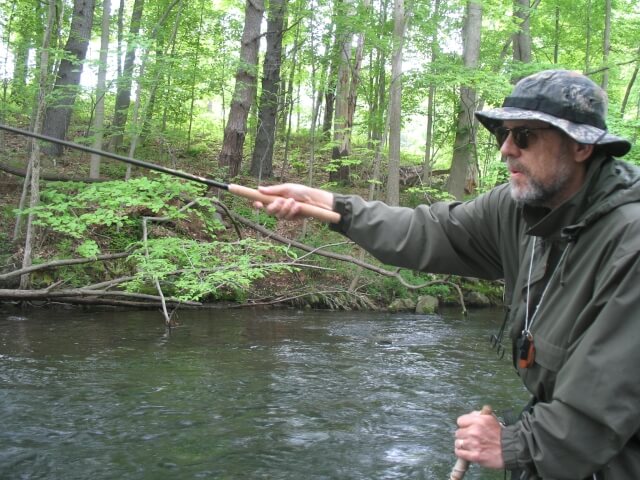 The Matag
The Matag
There used to be fishing / professional hunters (Matagi) who practiced fishing in the streams. A manuscript speaking of these professional fishermen is the diary of a British consul, dating back about 120 years ago in which he describes a climb on the Japanese Alps (2992 m above sea level). The consul accompanied the fisherman Toyama Shinaemon. In it he explains that the technique used by these fishermen was fly fishing. The fishing equipment used by Toyama Shinaemon can still be seen in the Alpine museum in Nagano.
Tenkara, fly fishing and Valsesian fishing
The fundamental difference between English fly fishing and that of Tenkara is that when fly fishing a reel is used and in the Tenkara method, no. Before the invention of the reel, which dates back to the 19th century, a fixed barrel was used with the fishing line made of woven horsehair as is still used in the actual Tenkara method and that of Valsesian fishing. The Japanese fishing rods were made of various types of bamboo, strictly selected for their lightness and length. The construction technique of bamboo rods progressed significantly towards the middle of the EDO period (300 years ago) and this is documented in a number of manuscripts of the time. At that time reed plugs with their special sheaths for transportation (very similar to the sheaths of Japanese swords - Saya) already existed. The first flies used in fly fishing were the submerged type. The introduction of the use of floating flies dates back to the last 100 years of history. Floating flies were never used in the Tenkara fishing technique. Furthermore the Tenkara fishing technique was only used for subsistance fishing.
Summer is gone and the opening of the refuge Regina Margherita is for June 2016. As of June 25 it will be possible to stay over again in comfort with all the amenities (including the Internet) in what is the highest refuge in Europe, the magical "Refuge" Margherita . From a height of 4,554 meters, the Regina Margherita Refuge is an exciting destination for all those who love the mountains, high altitude trekking and pristine landscapes. We are situated on top of Punta Gnifetti in the Monte Rosa range (Pennine Alps), on the Swiss-Italian border between the towns of Alagna and Zermatt.
The refuge has been here since 1893, when it was inaugurated with great fanfare in the presence of Queen Margherita (hence the name). About a century later (1979), for reasons of space, but not only, the original refuge was demolished and in its place the current refuge-laboratory was built, home to the highest fixed observatory in the world. To date the facility has 70 dormatory beds, a bar-restaurant, communal bathrooms, electric lighting, 220 volt and - thanks to the Polytechnic of Turin - even Wi-Fi connection!
Road access to the refuge and Vacation packages for summer 2016
The climb to Margherita hut requires some preparation, but that does not mean that only the most experienced and trained can engage in trekking. In the company of UIAGM mountain guides, anyone with discrete knowledge and adequate mountain climbing equipment can get to the top safely. The main access roads are 3:
1) from refuge G. Gnifetti across the Lys Glacier which is an approximate hike of 4/5 hours entirely on the glacier ( classic route);
2) from refuge Monte Rosa across the Grenz Glacier which is an approximate hike across the glacier itself of about 5 hours ;
3) from the bivouac L. Resegotti towards the SE ridge(Cresta Signal). In this case the Alpine itinerary presents a considerably difficult level.
One of the best ways to experience the extraordinary beauty of refuge Margherita without endangering yourself and others is to join one of the many tours that are organised during summer.
1) Trip to Capanna Margherita: 2 days of mountaineering with departure and return to Alagna with one overnight stop at refuge Gnifetti and reaching the refuge the second day.
2) Overnight in Capanna Margherita: 3 days of mountaineering with departure and return to Alagna, stopping over at refuge Gnifetti for the first night and the second in the highest refuge in Europe, refuge Margherita!
3) Ascent on foot to the refuge Capanna Margherita: 5 days of mountaineering and hiking, from Alagna until the heights of refuge Margherita.
Dall’allevamento alla trasformazione.
L’azienda agricola “Valsesia Cashmere” è una realtà che si fonda sul benessere animale, sull’ecosostenibilità, sul rispetto della vita e della natura, e il principio che ci ispira è che è moralmente giusto e materialmente possibile interagire con l’ambiente senza depredarlo, allevare degli animali senza abusarne, ottenere prodotti di qualità senza produrre inquinamento.
ALBERTO E FRANCESCA: fondatori di “Valsesia Cashmere”
Quest’avventura nasce nel novembre del 2008, con l’arrivo in Valsesia dei nostri primi 5 esemplari di Capre Cashmere, ossia Aristotele, Anastasia, Artemisia, Adelaide e Andromeda; a partire da quel momento i nuovi nati verranno “battezzati” ogni anno con nomi che hanno per iniziale la lettera dell’alfabeto successiva all’anno precedente. Dopo un periodo a Campertogno, in alta valle, le capre vengono spostate a Cavaglia Sterna, frazione di Varallo, dove col tempo a loro si uniscono altri animali: api, polli, pavoni, faraone, gatti, e ovviamente un cane da pastore, nella fattispecie una cagnolina di razza Briard di nome Anouk.
La capra Cashmere proviene originariamente dagli altipiani dell’Asia, è selezionata per vivere nei climi freddi ed ostili delle alte quote grazie al suo prezioso sottovello (il Cashmere, appunto) dalle straordinarie proprietà termiche. É una capra molto rustica e di poche pretese, che vuole stare all’aperto in qualsiasi stagione, prediligendo il freddo al caldo, e proprio questo rende il suo vello folto e pregiato; era quindi la razza ideale per vivere con noi a 1.500 metri di quota.
Il secondo motivo è puramente etico. É praticamente l’unica razza in cui nascere maschietto non è una sfortuna; i capretti maschi, infatti, se non servono per la riproduzione, vengono utilizzati per la produzione della fibra preziosa e non rischiano quindi di finire in forno!
C’è anche un altro motivo: quando, nel 2006, abbiamo visto le nostre prime caprette Cashmere ce ne siamo follemente innamorati…
Di qui l’idea di produrre un Cashmere totalmente Italiano, completamente ecologico e sostenibile sviluppando una microfiliera tracciabile dall’animale al prodotto finito.
Gita al Sas D'ot, 40' dal Ponte Gallo di Riva. Gita al balcone su Riva e il Monte Rosa, passeggiata in uso ai primi del '900 quando gli alberghi di Riva erano soliti organizzare in questo luogo pic nic e pranzi all'aperto
Vago nel bosco, un passaggio m'attrae attraverso il dirupo E mi prende il ricordo, d'esser stato già qui in altri tempi, dimenticati Un brivido lieve, il frusciar di una gonna un profumo di viola
 Varco la porta, e sono immerso in morbidi muschi. Velluto adagiato sulla vita che scorre. Dove son muri, prima eran coltivi che prima eran boschi, e nuovamente lo sono Così gira la ruota del divenire.
Varco la porta, e sono immerso in morbidi muschi. Velluto adagiato sulla vita che scorre. Dove son muri, prima eran coltivi che prima eran boschi, e nuovamente lo sono Così gira la ruota del divenire.
L'ombra del fitto si dirada alla luce Ora lo so, qui dovevo arrivare. Sulla valle è un balcone, di larghe vedute.

E ricordo le feste, il gelato, e le trine. Mi aggiro pensante, con passo lieve. Se ancor fossi fungo apprezzerei l'intenzione.
Dove sotto eran prati, e mucche festanti ora son case senza campane. Se coltivi qualcosa lo devi curare sennò sono erbacce, che dan poco raccolto.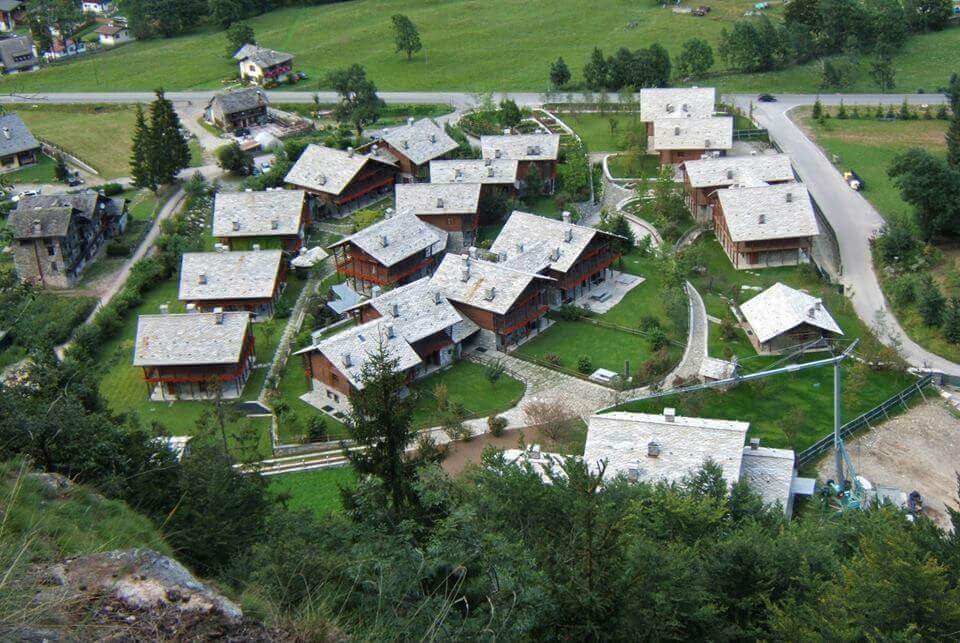
Ma eccolo il quadro e la cornice di rami, per vederlo un pochino mi devo addestrare... 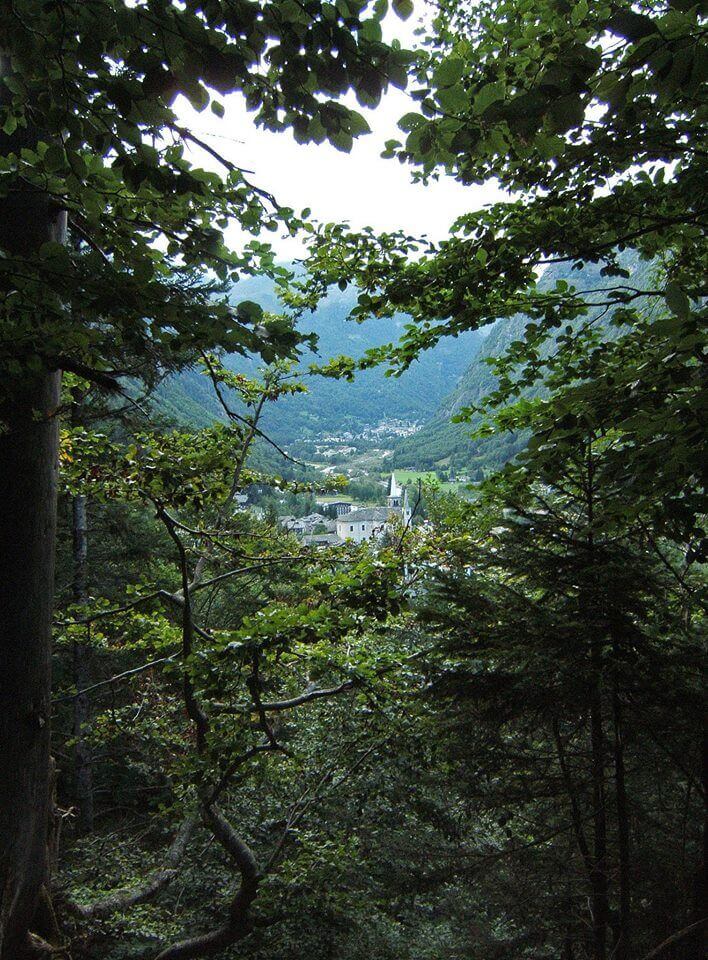 era più aperto nel profumo di viole ...
era più aperto nel profumo di viole ...
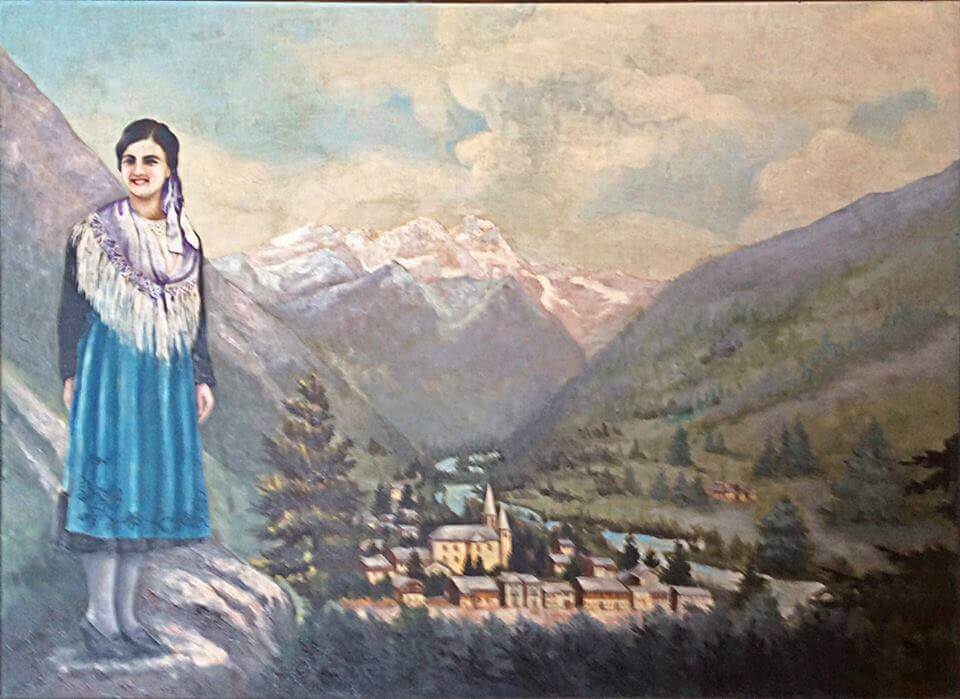
Ma il costone è ancor lì, che mi guarda di fronte e saluto quel cirmolo, che ha un falco tra i rami Solo tra i tanti, anche lui sul burrone un cuore esitante.
Giovanni Enzio
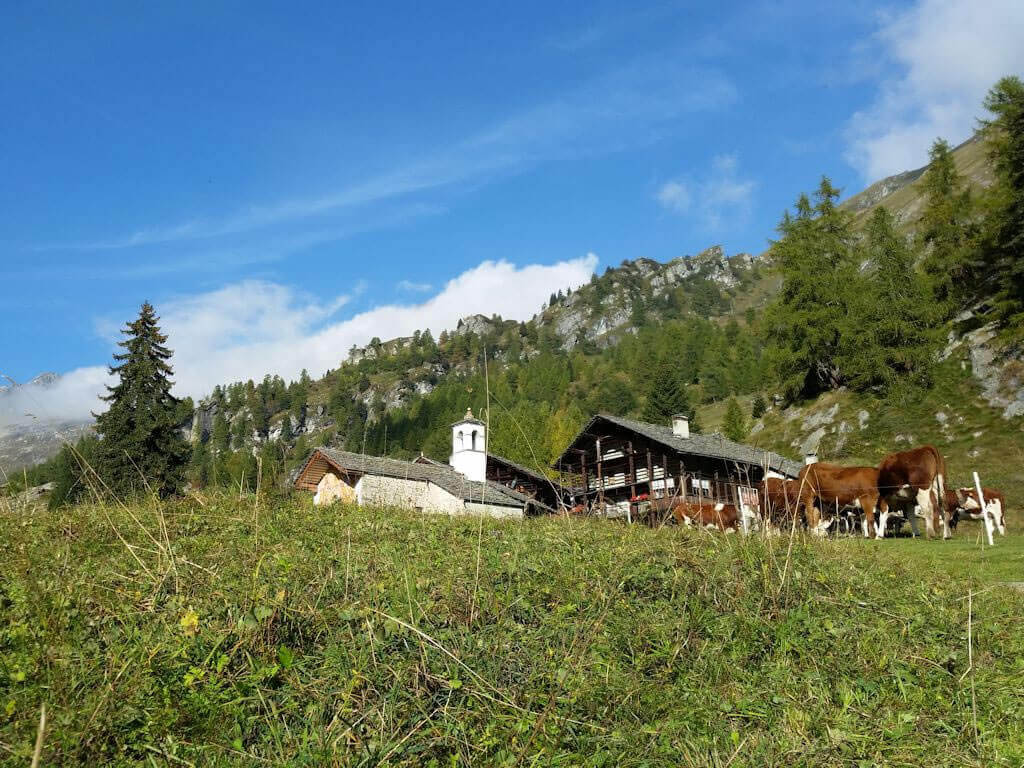 Per me andare a Otro è, ogni volta, un’emozione nuova, un mondo dove ritrovare me stessa, immersa negli armoniosi contrasti cromatici e suoni della natura che mi fanno entrare in simbiosi con tutto.
Per me andare a Otro è, ogni volta, un’emozione nuova, un mondo dove ritrovare me stessa, immersa negli armoniosi contrasti cromatici e suoni della natura che mi fanno entrare in simbiosi con tutto.
Era da mesi che non andavo a Otro, mi mancava e di recente ci sono tornata con un amico che non conosceva la valle, un’esperienza nuova che mi ha dato tanto nel poter trasmettere ciò che è per me la montagna, e la Val d’Otro in particolare.
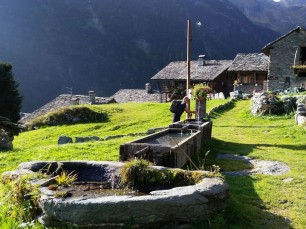

Siamo partiti da Alagna in una splendida giornata autunnale, di quelle in cui l’aria è intrisa di luce che fa risplendere i colori e di profumi tipicamente ottobrini.
Imboccato il sentiero n° 3 in Frazione Reale Superiore, nel bosco che accompagna fino alla piana si era avvolti dal brillare del sole tra le foglie ormai dorate, d’improvviso la scoperta della bellissima decorazione su un pietra raffigurante la Madonna ed una storia a Lei legata: “il Sasso della Madonna” che recita
“La Madonna ascoltò le loro preghiere e si caricò di tutti i loro fardelli.
Erano così pesanti che appoggiando la mano sul sasso per alzarsi,
lasciò per sempre la sua impronta”
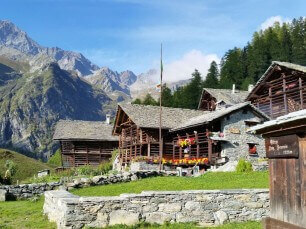 La salita continua fino ad arrivare nella piana dove, dove ci si trova in un anfiteatro naturale, accolti dalle mucche al pascolo, ormai scese dagli alpeggi più a monte, e non solo … il fascino delle baite Walser, immutate nel tempo porta sempre ad incantarsi nell’ammirarle.
La salita continua fino ad arrivare nella piana dove, dove ci si trova in un anfiteatro naturale, accolti dalle mucche al pascolo, ormai scese dagli alpeggi più a monte, e non solo … il fascino delle baite Walser, immutate nel tempo porta sempre ad incantarsi nell’ammirarle.
Qui abbiamo percorso il classico giro tra le frazioni, partendo da Follu, per poi raggiungere Dorf con la sua splendida fontana monolitica. Quindi a Scarpia e a Pian Misura, l’alpeggio di Otro, per poi riscendere diretti a Ciucche e poi a Fellerech dove stavano ristrutturando una baita nel totale rispetto dell’architettura Walser della vallata.
Difficile è stato lasciare quei luoghi ed incamminarsi verso Alagna, perché Otro sa dare emozioni nuove ogni volta che la si visita.
Gabriella Berlanda
Se volete fare una bella camminata al di fuori degli itinerari più noti e frequentati vi consiglio di provare a salire in Valpiana, un alpeggio nel comune di Mollia. Il percorso è molto suggestivo e si prende al di là di questa chiesetta, di fronte alla frazione Buzzo di Riva Valdobbia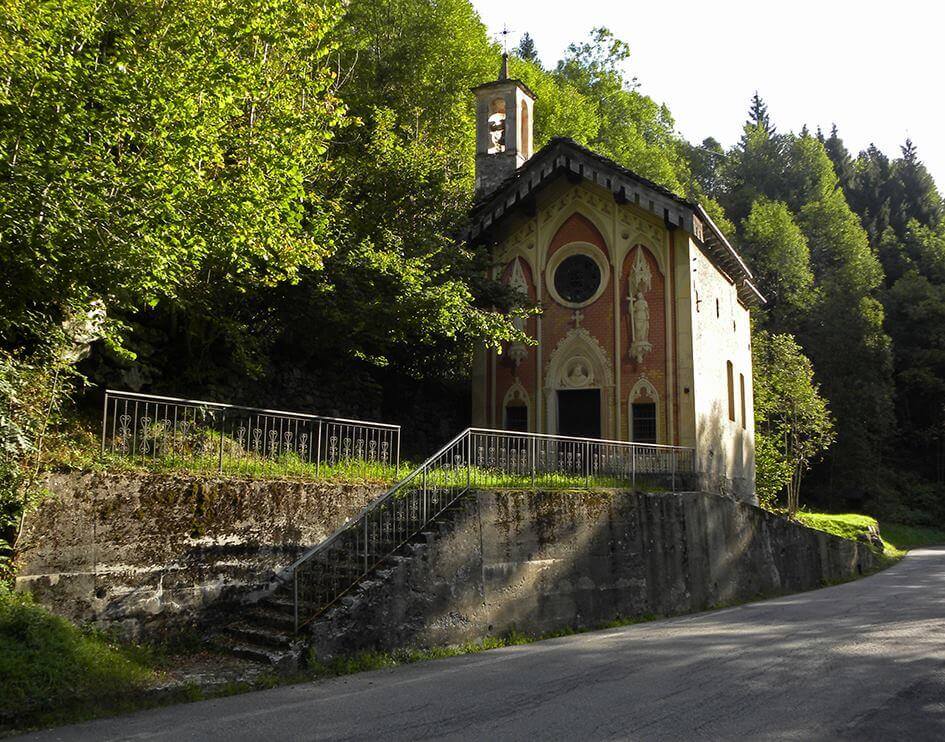
Il sentiero è segnalato con il numero 80
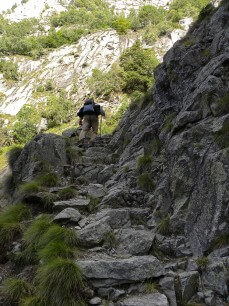 Nel primo tratto il sentiero si inerpica ginnico lungo un erto dislivello di 900 metri, con una gradinata sapientemente realizzata che supera i balzi rocciosi aggirandoli sulle cenge naturali presenti
Nel primo tratto il sentiero si inerpica ginnico lungo un erto dislivello di 900 metri, con una gradinata sapientemente realizzata che supera i balzi rocciosi aggirandoli sulle cenge naturali presenti
Dove non era diversamente possibile il sentiero è stato intagliato nella viva roccia; nel complesso risulta ben visibile, solido e ben costruito.
Resto ammirato nel considerare il tanto lavoro che è stato necessario per realizzarlo quando era "fame d'erba"
A quota 1.450 metri si incontra questo antro, scavato sotto un grande masso.
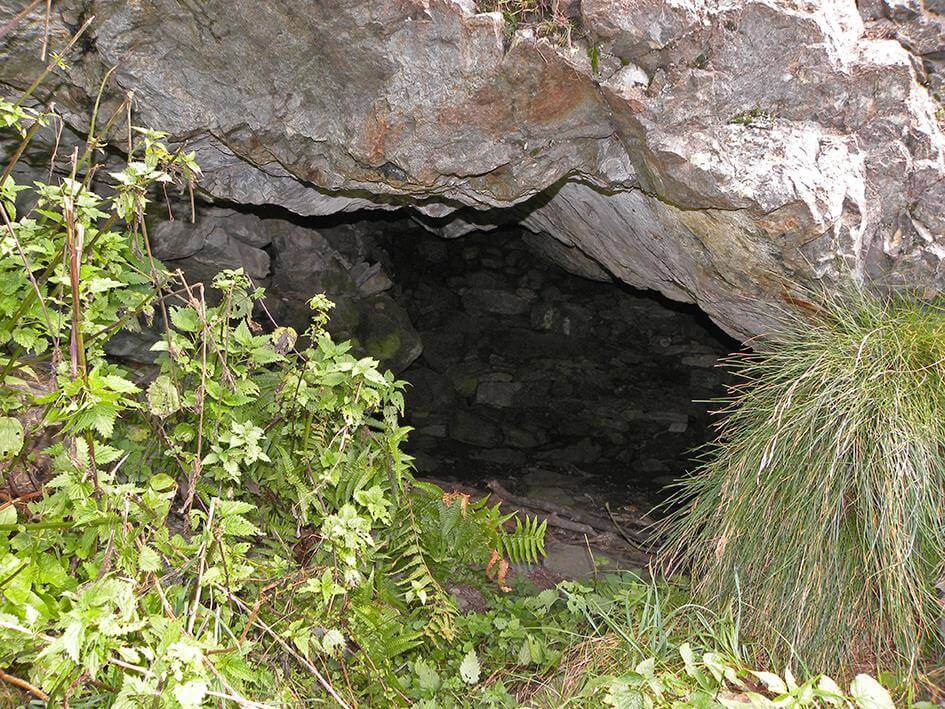
Ci sono entrato, e mi sono sentito come un topolino dentro una di quelle trappole che se appena tocchi qualcosa di sbagliato ti casca il soffitto addosso ...
Poco oltre, alla destra del sentiero, sgorga una fresca sorgente d'acqua. Alla quota 1.540, su una balza erbosa che si affaccia a strapiombo sul fondovalle, si incontra l'alpe Giacetto con i suoi maestosi frassini a candelabro 
Questi alberi un tempo venivano devotamente coltivati nei pressi dei casolari, e annualmente venivano potati per utilizzarne il fogliame, che era considerato un utile foraggio integrativo per gli animali, e le frasche venivano utilizzate per alimentare un fuoco vivace per scaldare il latte e fare il formaggio
Questa ripetuta pratica ha fatto assumere ai frassini la caratteristica forma a candelabro, Lungo tutto il percorso la dimensione verticale regna sovrana
Sul lato opposto della valle è visibile il pianoro e il casolare dell'alpe Otgnoso
Sullo sfondo svetta il Corno Bianco e biancheggia il nevaio di Puio.
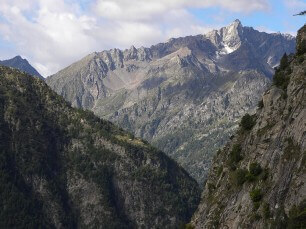 Sul lato opposto della valle è pure visibile il pianoro e i casolari dell'alpe Ghiaccio, incastonati tra ripide pareti rocciose
Sul lato opposto della valle è pure visibile il pianoro e i casolari dell'alpe Ghiaccio, incastonati tra ripide pareti rocciose
A quota 1.700 le latifoglie lasciano posto alle conifere
Sullo sfondo l'erto bastione roccioso della Punta Parete, regno e rifugio di aquile e camosci. Il giardiniere che si prende cura di questo versante è proprio un grande artista, e colori e profumi si mescolano armoniosi nell'aria. Siccome non hanno ancora inventato una macchina profumografica posso solo raccontarvi la luce, per gli aromi mi affido alla vostra immaginazione ...
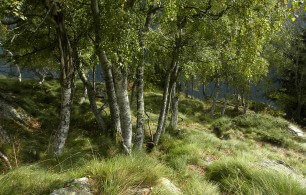 A quota 1.830 termina la salita del versante Valsesiano e si apre la visuale verso l'erba della Valpiana
A quota 1.830 termina la salita del versante Valsesiano e si apre la visuale verso l'erba della Valpiana
Sulla cresta di sfondo, al centro, è visibile lo stretto intaglio chiamato il "buco del tuono"
Qui si trova un morbido panettone erboso che si affaccia a precipizio sui paeselli del fondovalle.
Una "possa" è d'obbligo per rimirare il vasto panorama e riprendere fiato
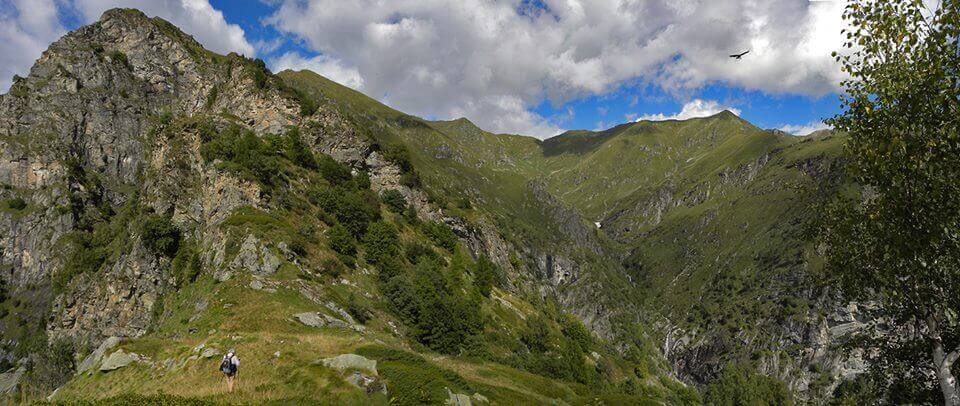 Da quassù mi viene da meditare sulle parole "valligiano" e "montanaro" e coglierne la sottile differenza, soprattutto in fatto di orizzonti.
Da quassù mi viene da meditare sulle parole "valligiano" e "montanaro" e coglierne la sottile differenza, soprattutto in fatto di orizzonti.
Lascio il morbido panettone che ha ospitato il tranquillo spuntino della mia "possa" e intraprendo la seconda parte della camminata.
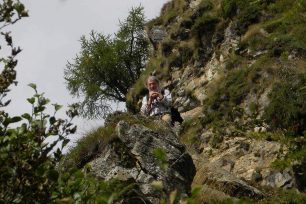 Ora il sentiero si inerpica per un ultimo tratto lungo una cresta rocciosa assai vertiginosa ma comunque agevole e ben percorribile. Il paesaggio mi assorbe, così mi sento un po' roccia silente che si crogiola al sole, e un po' gallo forcello infrattato tra i cespugli, fiducioso di poter sfuggire anche oggi alla zampata dell'aquila.
Ora il sentiero si inerpica per un ultimo tratto lungo una cresta rocciosa assai vertiginosa ma comunque agevole e ben percorribile. Il paesaggio mi assorbe, così mi sento un po' roccia silente che si crogiola al sole, e un po' gallo forcello infrattato tra i cespugli, fiducioso di poter sfuggire anche oggi alla zampata dell'aquila.
Il Passo della Cricca è collocato sulla sommità di questo sperone
Non ho dubbio nel pensare che percorsi alternativi sarebbero stati comunque più difficili da realizzare 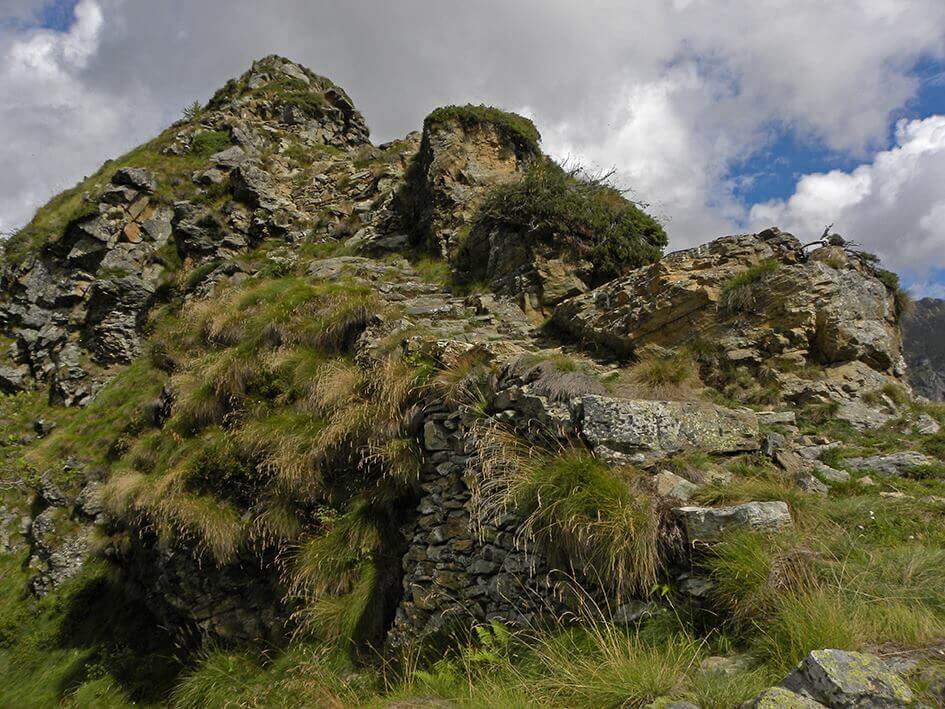 Giusto per ricordare che stiamo salendo in Valpiana il percorso gioca a fare equilibrismo sulla dorsale tra i due opposti strapiombi, ed ecco l'ometto del Passo della Cricca, a quota 1.910 metri, la porta della Valpiana, che come potete vedere di piano ha proprio solo il nome, Intanto laggiù il "buco del tuono" sta cambiando di umore (18)
Giusto per ricordare che stiamo salendo in Valpiana il percorso gioca a fare equilibrismo sulla dorsale tra i due opposti strapiombi, ed ecco l'ometto del Passo della Cricca, a quota 1.910 metri, la porta della Valpiana, che come potete vedere di piano ha proprio solo il nome, Intanto laggiù il "buco del tuono" sta cambiando di umore (18)
 Nel fondovalle, in basso a destra, 900 metri più sotto, le case della frazione Buzzo mi ricordano da dove sono partito
Nel fondovalle, in basso a destra, 900 metri più sotto, le case della frazione Buzzo mi ricordano da dove sono partito
Un poco più a sinistra è riconoscibile il ripido intaglio del Croso del Diavolo, detto anche Rio del Pecà ... chissà perché ...
E con questo ultimo tratto in equilibrismo tra i due versanti lascio la vista del fondovalle
Da qui in poi è tutto e solo "Valpiana"
 Oltre questa dorsale si trovano i casolari dell'alpe Valpiana.
Oltre questa dorsale si trovano i casolari dell'alpe Valpiana.
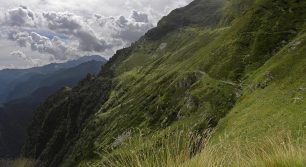 Mi volto indietro, e considero che effettivamente il sentiero in questo ultimo tratto è diventato pianeggiante, ancorché aggrappato sul ripido pendio. Alla sinistra dell'immagine è visibile il morbido panettone che ha ospitato la mia "possa" e poco più a destra è visibile il pinnacolo del passo della Cricca, entrambi a precipizio sul profondo intaglio scavato dal rio Valpiana. Ed ecco apparire i casolari dell'alpe Valpiana
Mi volto indietro, e considero che effettivamente il sentiero in questo ultimo tratto è diventato pianeggiante, ancorché aggrappato sul ripido pendio. Alla sinistra dell'immagine è visibile il morbido panettone che ha ospitato la mia "possa" e poco più a destra è visibile il pinnacolo del passo della Cricca, entrambi a precipizio sul profondo intaglio scavato dal rio Valpiana. Ed ecco apparire i casolari dell'alpe Valpiana
Là in alto le nuvole ora nascondono il "buco del tuono" e mi rendono un poco timoroso e inquieto, so che se vogliono possono diventare demoni
In basso resiste un nevaio di accumulo di valanga; siamo alla fine di settembre, forse quest'anno riuscirà a sopravvivere all'estate e ricongiungersi all'imminente bianco dell'inverno
E' così che nascono i ghiacciai, ed io tifo per lui, magari riuscirà a crescere quel tantino sufficiente a far abbassare un po' le penne al distruttivo dilagante spadroneggiare umano Nella semplicità costruttiva dei casolari ammiro questa porticina pazientemente ricavata con punta e mazzetta dalla viva pietra
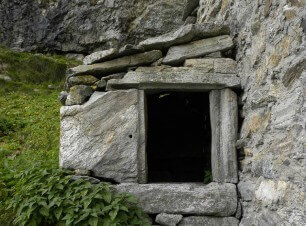
 La cantina del formaggio.
La cantina del formaggio.
Ai tempi della mia infanzia questo alpeggio ospitava mucche da latte di razza "antica" piccole e agili come capre
Ma ora gli umani preferiscono mucche esigenti, grosse e pesanti, impossibili da portare quassù, così questo alpeggio è diventato regno di capre e pecore.
Per la pausa pranzo scelgo di raggiungere l'acqua che scorre poco distante
Sul percorso incontro un recinto in pietra, fatto per liberare un poco di prato dai sassi, e diventare comodo ricovero notturno delle greggi
Il tempo di apparecchiare ed ecco scendere una pioggerellina leggera, di quelle che non bagnano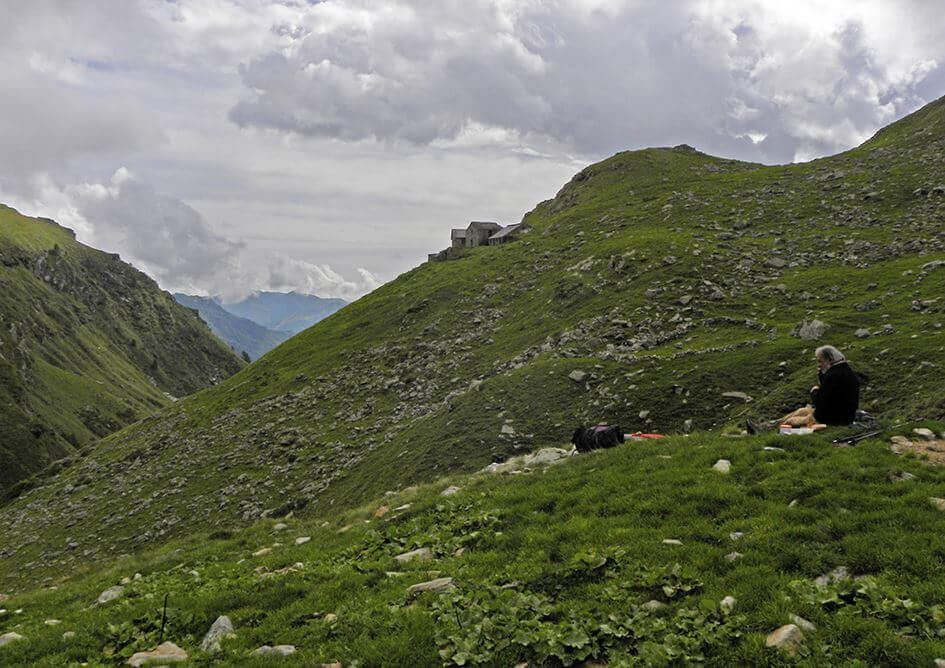 Le nuvole si stanno facendo più scure, e so che il "buco del tuono" non ci mette niente a risvegliarsi, così gli cantiamo una canzone, in allegria, magari per questa volta ci vorrà graziare ...
Le nuvole si stanno facendo più scure, e so che il "buco del tuono" non ci mette niente a risvegliarsi, così gli cantiamo una canzone, in allegria, magari per questa volta ci vorrà graziare ...
La mappa del percorso, tratta da OpenStreetMap
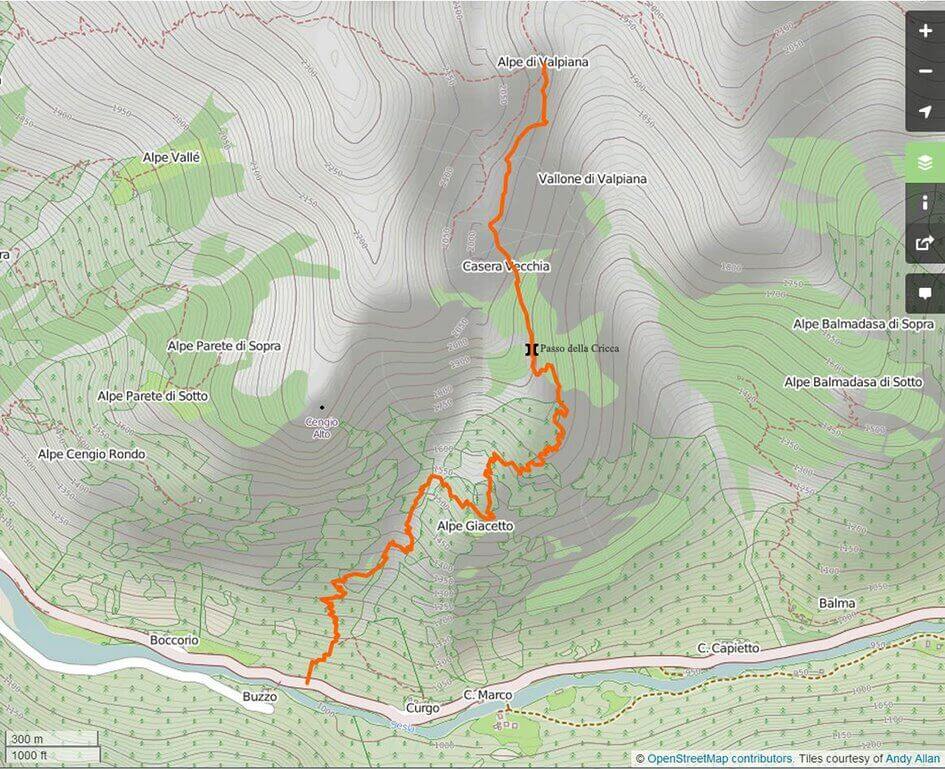 Un bel racconto sui pastori di Valpiana lo potete trovare qui
Un bel racconto sui pastori di Valpiana lo potete trovare qui

